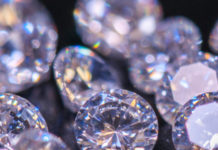
LUCARA Diamond Corporation said it had recovered another gem in excess of 1,000 carats from its Karowe mine in Botswana.
The 1,080.1 carat gem, measuring 82.2 x 42.8 x 34.2 milimetres, is described as a “Type IIa top white gem of high quality” and was mined at Karowe’s South Lobe. It is the fourth +1,000 carat diamond from the area since 2015.
Other notable recoveries include the 1,758 carat Sewelô (2019), a 1,174 carat diamond (2021), and the 1,109 carat Lesedi La Rona (2015), said Lucara today.
“Lucara is extremely pleased to be reporting the recovery of another large, high quality gem diamond,” said Eira Thomas, CEO of Lucara. “As we progress mining deeper in the open pit and transition to underground mining, exclusively in the South Lobe, the preponderance of large, high value stones is increasing,” Thomas said.
The diamond discovery will be a welcome highlight in Lucara’s interim results presentation on Thursday (August 10) where questions are bound to be asked of the ongoing implications of a project cost blowout of Karowe’s underground expansion.
The Toronto-listed company said in July that the expansion would take 18 months longer to complete than first planned while the project’s capital costs would increase a quarter to $683m.
First production from Karowe’s underground section was now planned for the first half of Lucara’s 2028 financial year instead of the second half of the 2026 financial year as previously planned.
There had been an estimated 28% increase in construction time after Lucara encountered more underground water than expected. Grouting, intended to stem the presence of water, had therefore taken longer than expected.
The capital cost increase would be funded through contingency provisions.
Thomas said the discovery of the diamond was consistent to with resource model and underpinned “the strong economic rationale for investing in the underground expansion that will extend the mine-life out to at least 2040”.











